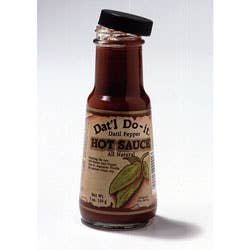
The habanero chile, a small, flat, bell-shaped fireball from Mexico's Yucatan Peninsula, is one of the most incendiary peppers on the planet. How hot is it? Measured in Scoville units (named after Wilbur L. Scoville, an American pharmacist who in 1912 devised the technique used to measure a pepper's pungency), habaneros top the charts at up to 300,000. In comparison, jalapeños, which some people have been known to consider rather incendiary, measure a mere 35,000 to 45,000 Scoville units.
But an obscure cousin of the habanero, which has flourished in the home gardens of St. Augustine, Florida, for more than 200 years, has recently emerged as a contender in the hot-chile major leagues. This is a small, green number, anywhere from half an inch to four inches long, called the datil chile. Though most other varieties of hot chile belong to the Capsicum annuum var. annuum or C. frutescens species, datils—like habaneros—are apparently C. chinensis. Like habaneros, too, datils test high on the Scoville scale—in their case, a mouth-numbing 220,000 units.
Legend has it that the chile arrived in America's oldest city in the mid-1700s, brought by immigrants from the Spanish island of Menorca. The Menorcans, who became a dominant presence in St. Augustine, probably gave the pepper its name, since its wrinkled appearance suggests a date—datil in Spanish (and datil in Balearic Catalan).
Though Menorcan food in Spain today isn't spicy in the least, the Menorcans of St. Augustine have used datils copiously in their cuisine for generations—either fresh, marinated in vinegar or sherry, or turned into relish or homemade hot sauce (most often, at least in recent years, a homey concoction of chiles, vinegar, and ketchup known as "bottled hell").
In 1981, datil expert and St. Augustine restaurateur Chris Way created a slightly more sophisticated hot sauce for his restaurant, using datils as the base, but eschewing ketchup. He originally intended his mixture to be a dipping sauce for oysters and fried shrimp—but when patrons began smuggling bottles out of the restaurant, to slather (they confessed) on everything from omelettes to tuna sandwiches, Way decided to manufacture the stuff. Thus was born Dat'l Do-it Hot Sauce—the first commercial preparation using the chile.
The formula calls for blending datils with fructose, vinegar, lemon juice, honey, salt, assorted spices, tomato paste, water, and garlic. The resulting hot sauce has a subtle sweetness with a tomato kick that makes Dat'l Do-it—unlike some other fiery condiments—appropriate for glazing grilled meats, or as a complement to shellfish. And don't forget those tuna sandwiches.
Dat'l Do-it, Inc. now turns out a full range of datil-based products, from mild pepper jelly to spicy Devil Drops, a Tabasco-like sauce that definitely needs to be measured out in small doses. Hellish Relish, which combines the chile with cabbage, vinegar, onion, and tomato puree, also shows off the datil's ability to heat things up. Yet another product is a Menorcan-style mustard, also liberally spiked with datils. The company has a website (www.datldoit.com), as well as—what else?—a hotline (800-468-3285).
Keep Reading
Continue to Next Story










